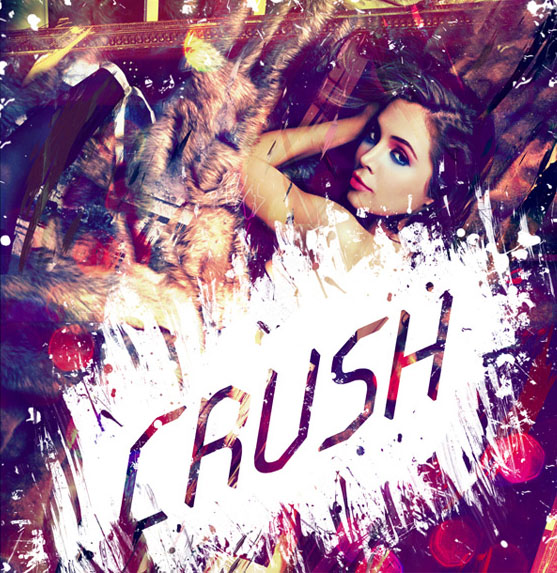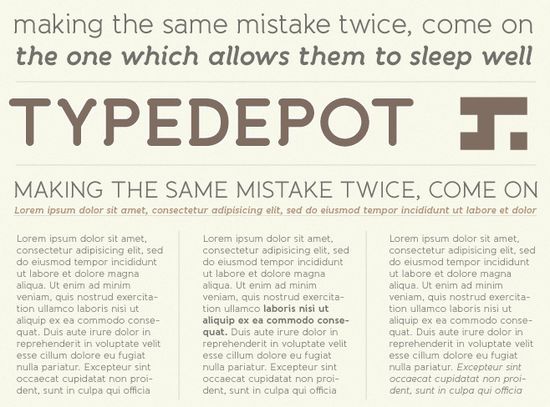
Editor's Note: Fonts are to design, just like temperament is to people. Whether it is gentle and elegant, modest and polite, or lively and bold, all of which are shaped through the structure of the font. Only by understanding the temperament of each font can it be placed in a suitable place. Today’s good article is to spread a little knowledge of English fonts with students.
Recently (before the exam) I was watching "Font Story", and by the way, I studied English typography. I deeply feel that this is a knowledge that can improve quickly (beep –). I wrote this in English class pre and papers, which was greatly "admired" by the teacher. Recently, I have written a lot of English papers (mainly about cells). I experimented with different fonts in each paper and printed them out to test the effect. When reviewing at the end of the term, I will also pay more attention to what fonts the teacher uses and what fonts are used in the thesis. Interesting discoveries include: Cell is the only one that uses a sans-serif font (Helvetica) for the text, Science uses the ancient Minion, and Mr. Wei’s PPT uses the simple Univers, etc.
So, after reading so much, I have improved so much, so I come here to popularize some practical knowledge~
Before continuing to look down, please understand the concepts of "serif" and "serif".
The alphabet system of Western countries is divided into two categories: Serif>
Serif>
Serif>
Sans>
The Song typeface in the Chinese font is the most standard Serif>
This film only discusses the use in documents, although most fonts will also be used in presentations (PPT), but it must be noted that letters are presented in small sizes (8-16px) and large sizes (above 32px) The focus is completely different, so this is something to pay attention to.
The choice of title font:
It’s rare to see publications with serif headlines these days (the New York Times uses gothic for historical reasons aside), so it’s wise to make a sans-serif headline for your article. Bolding is also a good idea; if you want to look very technological, then you can go to the other extreme and use Ultralight (extremely thin), such as Apple’s publicity that often uses ultra-fine Helvetica.
It is a safe bet to use typical Swiss typefaces (including but not limited to Helvetica, Arial, Akzidenz-Grotesk, Univers, Frutiger) which differ little in the eyes of non-professional type designers ( So the specific difference will not be discussed here), especially after adding boldness, it will create a rigorous and dignified title, which is neutral yet eye-catching. It is almost a "never wrong" font for title design.

Of course, if you want more styles, you can try Futura, a minimalist German font, which has a very industrial and avant-garde feel. Of course, you can also use Gill-Sans, a typical British font, which can reflect a semi-archaic feeling, which is more gentle and helps to narrow the distance between you and the reader. CenturyGothic and Optima are also good choices, the former has an artistic minimalist style, and the latter has a gorgeous feel due to its arched stroke ends and variable stroke weights. Of course, it can also be a font that shows strength and determination like Gothem, which is usually used on slogans.
Choice of body font:
The choice of body typeface is a very divisive one. Serif and sans serif fonts convey completely different feelings.
First of all, let’s talk about traditional serif fonts: In fact, it is not difficult to choose serif fonts in the text, because most serif fonts are similar in small font sizes. I once tried to change different parts of an article into different fonts (about 13px) and print them out. Unfortunately, the printing paper used is a little blurred, and the strokes of the characters have obvious irregular thickening. In this case, there is basically no difference in the look and feel of different fonts even on a piece of paper. It can be seen from this that, in fact, the serif fonts are actually not much different in the case of printing quality/small font size.
Of course, considering that it is all laser printing now, some options are still necessary, so: give up Times >
Times is indeed a well-designed font, but its popularity is only so wide because it was embedded as a default font in early Windows. Excessive use has given the font a Kumon-like tiredness. Another reason for abandoning Times is that it is a "newspaper" font, and its original intention was to make a font for Times in the UK. The biggest feature of newspaper fonts is that the width is relatively narrow, so that more content can be placed on the newspaper. As a result, an illusion of cramped layout is created in the text.
Palatino, Garamond and Minion: Typical classical Venetian fonts, belonging to the oldest Roman font styles (before only Gothic). It is characterized by a smaller arc at the tail of j, a relatively high upper part, and relatively small pockets and bowls. Since the printing technology at that time was really not high, many designs were designed to improve readability under poor printing quality. cannot be printed). So if the expected print quality is poor, give these fonts a try. The feeling conveyed is very similar to the style of Renaissance books, or official documents of the 17th and 18th centuries. It gives people an old-fashioned feeling that every word is carved. Old and formal. The current text of Science is Minion. Another hint is that the "Declaration of Independence" used Garamond, imagine that feeling?

Baskerville: One of the most classic fonts. Its characteristics are gorgeous and classical. As a "transitional" font born in the 17th century (Times is also a transitional font), Baskerville has a more significant thickness contrast than classical serif fonts, and is more gorgeous in details (such as the tail of g and tail of Q). The use of Baskerville font allows the text to have a typical romantic style, just like opening a love novel in the 17th and 18th centuries.
Didone (Didong) body (note that there is no font called Didone), mainly Bodoni and Didot. A typical French font, modern and sexy. Very strong stroke weight contrast with peaceful thin serifs. Some of the more successful design cases, for example, are on the perfume bottle. Of course, this sexy attribute is not obvious in the case of small font size, so don't worry. Using Didong style can give readers a very modern feeling. For example, some fashion magazines are better applications. However, one thing to note is that if the printing quality is not flattering, it is best not to use this font, because the contrast between strokes is too strong, and thin serifs may not be printed easily.
If you really like Times, give Georgia a try. Microsoft's modernized Times. Add some modern elements (such as flat serifs). But to be honest, I don't like it very much. Gives a sense of public culture.
Although the various fonts mentioned above have various styles, they are all suitable for formal documents because of the nature of their serif fonts. (Don't be afraid to use Di Dong's sexy body, it's just when he zooms in)
Tell me about sans serif fonts:
The most widespread use of sans serifs is in the electronic world. Comparing sans-serif and serif fonts is like pencil vs pen. The biggest feature of pencil characters is that they are very featureless and extremely plain. This is also a concept of sans serif font design: the concept of transparent containers. It is said that the font itself should not convey any additional meaning, but only the meaning of the text itself, just like a transparent container that only shows the contents without showing the attributes of the container.
Calibri, Segeo, DroidFonts: This refers to a new generation of system default fonts. It perfectly implements the concept of transparent container and legibility. Their style is completely lacking in style, neither the formal, classical feel of classical serifs nor the futuristic or design feel of 20th century sans serifs. Yes, they convey almost nothing! The extremely strong sense of official documents of a modern large enterprise cannot even be described as cold, because he does not convey any feeling at all, it can only be described as a "cold" feeling. Although it can be boring to read, it can never be used wrong!
Gill>

Swiss fonts (including but not limited to Helvetica, Arial, Akzidenz-Grotesk, Univers, Frutiger): the earliest and most classic sans serif fonts, milestones in the history of font design. It has a good sense of design, although it may sometimes feel boring like Calibri when used in a large area, but it is not that strong. Much like the body copy of a well-designed advertising flyer, refined, graceful and rigorous.
Optima:>
Verdana: Another classic font from Microsoft. It has some references to geometric sans serifs, but its readability is quite good. It is also the first batch of web-safe fonts and is widely used. It is characterized by large characters and wide characters, which has the feeling of modern commercial promotional materials. IKEA is used for all labels, think about the IKEA feel, business-design-popular feel. Very gracious and friendly. Pay attention to reduce the font size when using it.
Geometric sans serifs (such as Futura and Century>
Trebuchet: Not very recommended either. A very strange font designed by Microsoft in the early days. It is a bit like a monospaced thick serif (SlabSerif) font design (although it is not). It may be for normal display on many early low resolutions, deliberately sans serif There's something like thick serifs on it. Unless you want your files to look like official reference documentation for programmers. It's very Geek and feels a little dull.
A final word on old wisdom, which says: "Use serif for text, sans for titles, and sans for legends." This is still the case in most formal publications and documents. It is very common, or it has formed a golden rule-style specification. For example, I picked up a Lehninger (really handy, I didn’t take the time to carefully identify the fonts in it, so don’t spray if you make a mistake...), the title uses a thick and narrow sans serif (sorry For the time being, I won’t identify it without research on the narrow body), the figure annotation seems to be a sans-serif Optima, and the text uses a serif font similar to Georgia.

However, this wisdom has a tendency to become obsolete, one of which is that Cell has been fully Helvetica (the most famous type of sans serif) font. There are three main reasons for the development of sans-serif: First, the quality of printed matter is getting better and better: in the case of perfect printing, sans-serif fonts can use many methods (such as increasing the x-height) to make up for small characters that are relatively inferior to serif fonts Second, at the beginning of the digital age, due to the resolution of the screen, serif fonts may be deformed and look ugly under certain resolution conditions, so sans serifs are very common in the IT field (just open a Big websites are all sans-serif); the third point, it is hard to say whether it is the reason or the result, is that the design concept of "less is more" (Bauhausism is one) became popular after World War II, sans-serif The font just happens to be very much in line with this trend of thought.
Although there is nothing wrong with using sans serifs for the text in many places (except for more conservative places, such as academia), but because sans serifs sometimes give people a very boring feeling, although theoretically sans serifs can be used by heightening "x The method of "high" makes the readability not inferior to the serif font at all, but I personally feel that reading long articles without serifs is easier to get tired.
Summary
It is better to use sans serifs for small-scale promotional materials, illustrations, summaries, or other places; it is better to use serifs for long-form or literary things. Because the associations corresponding to serifs are long essays or novels, and the associations associated with sans serifs are more graphic associations (or sans serifs are better suited to pictures). Therefore, all documents with rich pictures and texts should consider partially or completely using sans serifs, while plain texts should give priority to serifs. Another reason is that sans serifs are easy to be boring, and more pictures can be adjusted.
As for the title, boldly sans serif! In terms of eye-catching degree and design sense, the height of sans serif is far beyond that of serif.
and:
Because many promotional slogans with a strong sense of design use Ultralight or Semilight fonts, I would like to talk about this issue here. Thin fonts are really not very good for body text, because thin fonts are too thin in small font sizes, which is not conducive to reading and tires the eyes. The essence of the text is that everything is legible first, so it is not recommended to use thin fonts. The author sometimes uses thin fonts in the references, because no one will read the references carefully (most of them copy and paste the original text), and the small font size will have a weakened feeling, which is very in line with the positioning of the references .
Speaking of fonts, the editors of these three articles can't wait to send them by hand:
After reading the summary, let's add a little knowledge of English font classification: "Can't choose fonts? Let’s take a look at the 7 types and characteristics of fonts》
If you feel that the traditional large fonts cannot convey your unique inner temperament, try this; "This effect is super hot!" Teach you to create tall polygonal fonts》
What should I do if I accidentally see a tall font but don’t know what it’s called? Click below: "Still asking "what font is this?" Four artifacts can help you! "

Original address:jianshushadowfox
【Youset.com submission mailbox: 2650232288@qq.com】
Unique Design-UISDC
Public account: youshege
learn design here
www.uisdc.com
·Here are the most cutting-edge design tutorials ·Never outdated web design cases ·Global popular design material downloads
Enjoy a new learning experience with the mini version of your mobile phone Click ☞read the original text in the lower left corner to go to the mobile version of Uniset to learn
©UISDC2014.ALLRIGHTSRESERVED.
Articles are uploaded by users and are for non-commercial browsing only. Posted by: Lomu, please indicate the source: https://www.daogebangong.com/en/articles/detail/Never%20worry%20about%20font%20selection%20again%20Super%20comprehensive%20English%20font%20summary.html

 支付宝扫一扫
支付宝扫一扫 
评论列表(196条)
测试